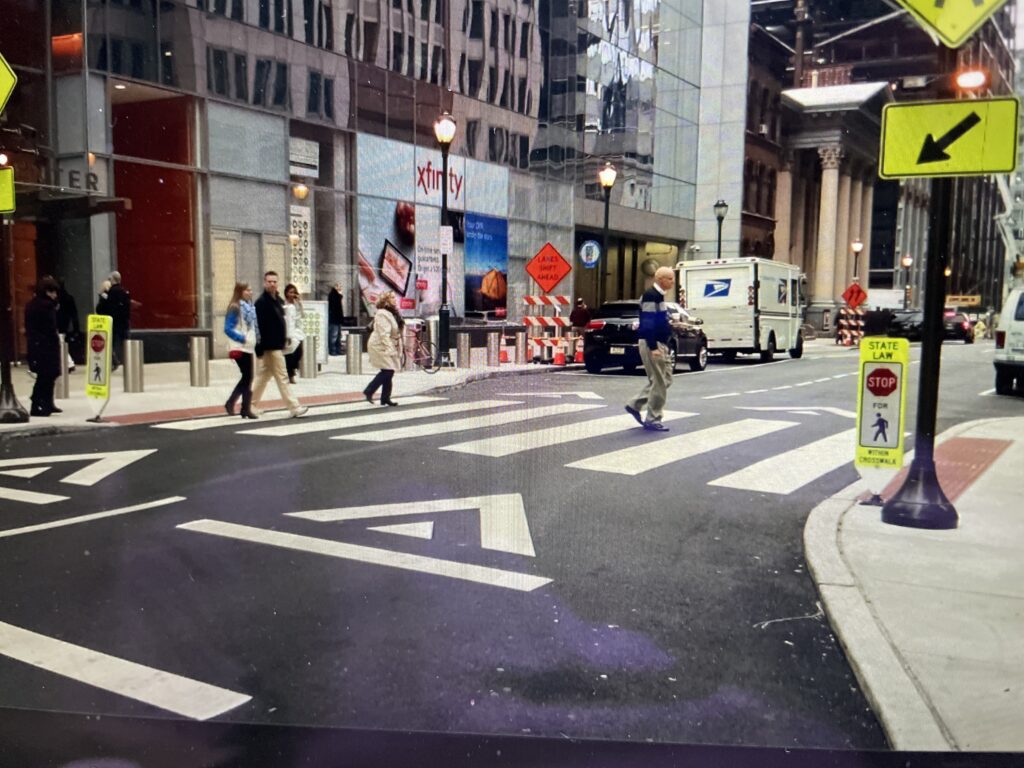
The insistence that pedestrians cross at intersections treats pedestrians and other vulnerable road users just like vehicular traffic and force them to behave as such, waiting their turn at an intersection. That seems a bit inequitable.
After a research dive I wrote about how Vancouver created “jaywalking lines” to get pedestrians to conform to walking between painted white lines at intersections in 1918. There’s also a history of shaming walkers that would have tried to cross the street mid-block, which is actually safer as there are only two traffic directions, not four as at an intersection.
The term “jaywalking” referring to walkers crossing midblock was embraced by the automotive industry in the 1920’s to free up the street for rapidly moving vehicles. Pesky pedestrians were relegated to intersections that were controlled by engineering traffic standards, with the concept that traffic engineers were better judges of pedestrian safety than the pedestrians themselves.
There is a sad reality on our fatality statistics in Metro Vancouver and in most places. The majority of fatalities are pedestrians over fifty years of age, mostly men, who are crossing at intersections WITH the walk light. And how are pedestrians getting injured and dying? It appears that the majority of crashes seem to occur with drivers turning left through the intersection when the pedestrian has the right of way.
Work with Vision Zero in New York City refers to every life using the road as being important, and strives to have no deaths or serious injuries due to road crashes. New York City is revisiting the mid-block pedestrian crossing and finding that it is safer.
Even in the 1990’s research conducted by the US Transportation Research Board found that 26 percent of all pedestrian accidents occurred by the “midblock dash”, 25 percent at intersections, and 50 percent by random vehicles mounting curbs and other random crash sites. This shows that those marked crossings at intersections are not as safe as assumed.
The American Federal Highway Administration (FHA) striped intersection pavements with the assumption that pedestrians are safer crossing at intersections with traffic lights and all kinds of turning movements versus mid block two-way vehicular traffic. That has proven not to be the case.
Installing correct, visible midblock pedestrian crossings would mitigate crashes and the FHA estimates that these crossings are workable at speeds of 30 mph (50 km/h). Mid-block crossings can be hard to use for visually impaired people, and do require education for drivers to be alert for them.

Quebec had implemented no right turns at intersections on red lights, but that has been repealed and now Montreal alone has that legislation. In terms of making pedestrian crossings safer, well lit intersections, slower mandated road speed and “leading pedestrian intervals” (LPIs) can save lives.
Leading pedestrian intervals refer to crossing lights being reprogrammed to give pedestrians a three to ten second start to cross the street before vehicular traffic is allowed to proceed through the crosswalk. New York City has over 2,200 of these leading pedestrian intervals where their policies prioritize safety of walkers over vehicular movement. New York City has a 56 percent decrease in collisions where the LPIs were installed.
NACTO, the National Organization of City and Transportation Officials estimates that LPIs can reduce pedestrian crashes by 60 percent. Costs to install leading pedestrian intervals are nominal, about $1,200 USD per intersection.
The cities of Vancouver and Surrey have implemented LPIs and should be installing more. There are currently 19 Leading Pedestrian Interval signals in Vancouver with plans for an additional 10 in 2021. The City of Surrey has installed LPIs at 88 of their intersections.
If we are serious about encouraging sidewalk users to walk and roll to schools, shops and services, we need to look at how to get them across roads safely. It’s well worth revisiting the midblock crossing, and investing in LPIs which are cheap to install at existing intersection crossings, and which are demonstrated to save lives.
Here’s Shabnem Afzal, the Manager of the Vision Zero program with the City of Surrey describing how Leading Pedestrian Intervals work.
images:uctcsrts.com,xwalk.com













Mid-block crossings also have higher crash rates than controlled intersections because so many of them are lazily slapped across multi-lane arterials. One vehicle may stop but it obstructs sight of the pedestrians who are crossing from the second or third lane of vehicles coming in the same direction. It’s terribly negligent design but from many agencies’ perspectives, a few dead pedestrians is worth not having to narrow a busy roadway and sometimes inconvenience the motorists who drive on it.
As an avid walker I think the LPI is a good idea but need to educate the drivers to look at the light not the pedestrian walk signal. Recently as I was crossing Broadway at Yukon at a LPI 2 cars went through the intersection against their red light. I assumed they saw the pedestrians walking and not looking at the red light went through. Luckily they weren’t making left or right turns as they would have possibly taken out a pedestrian!
Spot on. Another relatively low cost measure that significantly simplifies pedestrian ‘workload’, both at midblock crossings and where major streets intersect minor streets (no signal), is the median refuge or pedestrian safety island. People crossing can give their undivided attention to one direction of approaching traffic at a time, a significant benefit especially for young and elderly. https://nacto.org/publication/urban-street-design-guide/intersection-design-elements/crosswalks-and-crossings/pedestrian-safety-islands/